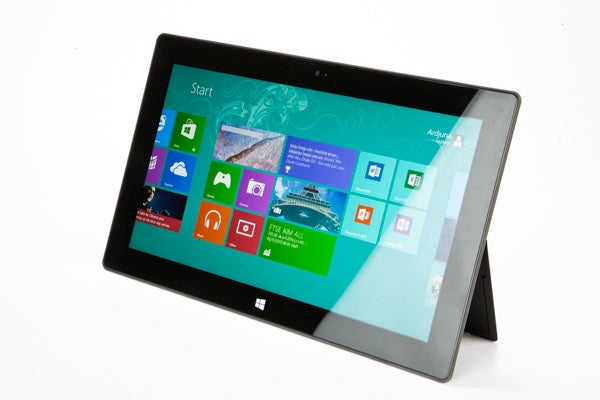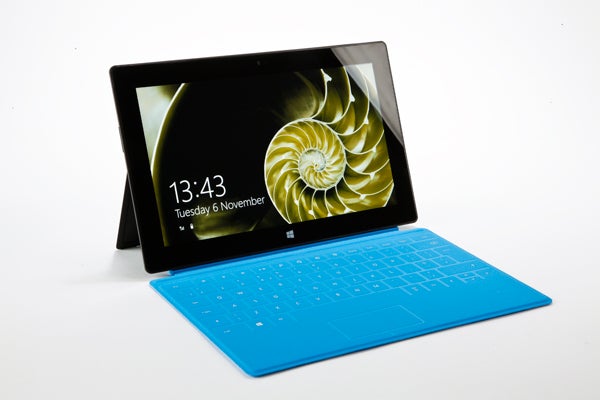Microsoft Surface Review
Microsoft Surface
Microsoft’s first tablet with Windows RT is impressive and offers excellent productivity potential.
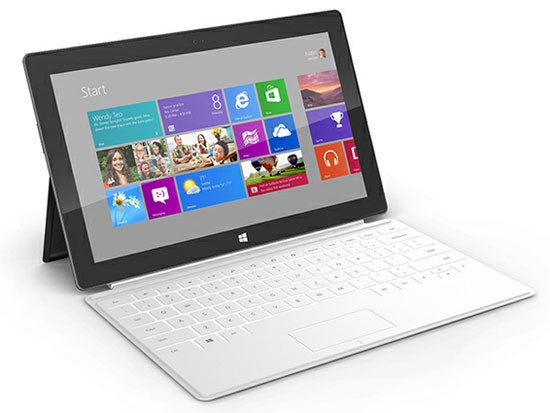
Verdict
Pros
- Great screen
- Excellent speakers (for a tablet)
- Unique, durable design
- Good performance and battery life
- Superb keyboard cover(s)
Cons
- Low screen res
- Rubbish cameras
- No NFC or 3G/4G
- Not as comfy to hold as some
Key Specifications
- Review Price: £399.00
- Tegra 3 quad-core CPU, 2GB RAM, 32/64GB expandable storage, USB 2.0
- Keyboard covers with touch or physical keyboard
- Windows RT for ARM
- 10.6in 1,366 x 768 IPS screen with Gorilla Glass 2
Introduction
Microsoft Surface is big. Not literally, as it’s actually a slim and light 10.6-inch tablet, but Microsoft’s Windows 8 RT tablet is a true milestone for the world’s largest software company and creator of the Xbox games console. For starters, this is Microsoft’s first tablet and, more importantly, it represents its first ever PC device.
Does the Microsoft Surface Pro 2 have anything more to offer?
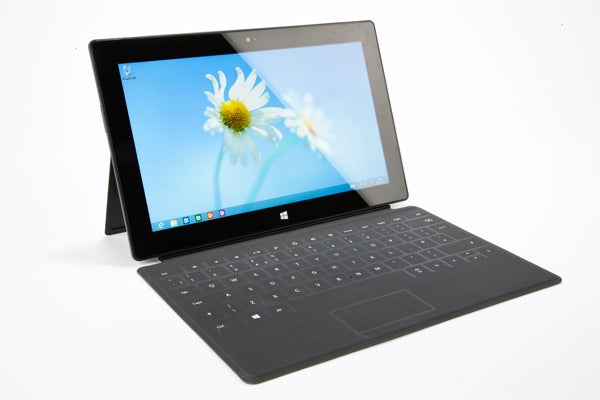
Though MS has a lot of hardware experience with designing peripherals, media players, and of course the aforementioned consoles, the maker of the world’s most popular operating system for computers has never designed one itself. This alone makes Surface a very big deal – though as a replacement for your PC or laptop, Surface Pro, which will be launching early next year with a Core i5/7 processor, probably makes more sense.
Wondering which Windows 8/RT device to get? Have a read of our Best Windows 8 Laptops, Tablets, Convertibles and PCs roundup
Microsoft Surface – up against the iPad and Nexus 10
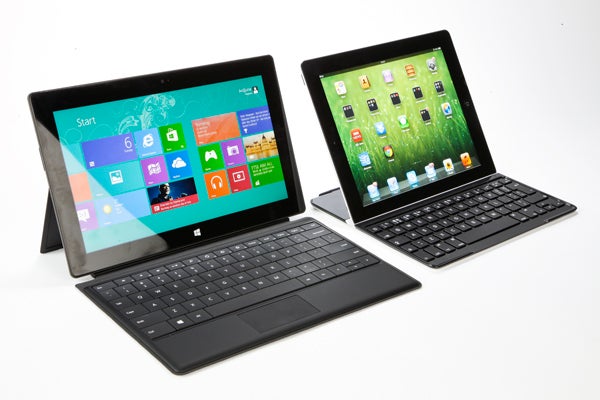
Microsoft Surface with Type Cover on the left, iPad 2 with Logitech Ultrathin Keyboard Cover on the right.
As a tablet, Microsoft Surface is just as important. Unlike the Surface Pro which will essentially offer laptop power in an tablet-like package, the Surface, which starts at £399, will go up against the Apple iPad and Google Nexus 10. Both of these players – with iOS and Android respectively – have had the tablet market virtually to themselves since the original iPad, and now have a strong hardware line-up too. So can Microsoft’s tablet establish itself when it’s so late to the party and costs nearly as much as a (lower capacity) iPad 4?
Microsoft Surface – Tablet Launches Windows RT
On the software side meanwhile, Surface is big because it’s the launch hardware for Microsoft’s Windows RT, essentially Windows 8 for ARM devices. Existing separately from Windows Phone 8 and regular Windows 8 for X86 architectures, RT faces an uphill struggle as it doesn’t offer the legacy support of Windows 8 and (for now) its app catalogue is woefully small compared to its main rivals. 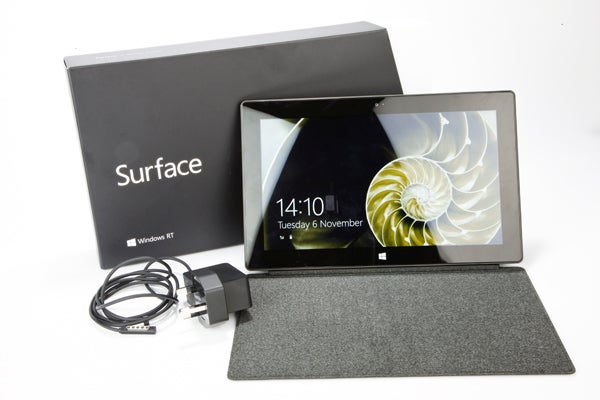
Showing the Microsoft Surface box, Surface power adapter and rear of the Touch Cover
However, there’s some big-time compensation in the inclusion of a full version of Microsoft’s own Office 2013, which is a major draw for those wanting to use their tablet for productivity as well as entertainment and content consumption. It would also appear that it’s very easy to convert Windows apps to work on Windows RT, so we’re likely to see the Windows Store grow quickly on both of Microsoft’s platforms.
Microsoft Surface – Design and Build
Surface is a beautifully designed tablet with its own unique aesthetic. It has had obvious care put into the details and offers superb build quality – though it does suffer from a few minor niggles.
The first thing you’ll notice when you take the Microsoft Surface out of its nicely presented box is just how thin and wide it is. With a 16:9 aspect ratio rather than the 16:10 of most Android tablets or the 4:3 of the iPad, this Windows RT tablet shares its shape with the average TV or laptop. It also shares its 1,366 x 768 resolution with the majority of laptops and HD Ready tellies, which means content formatted for those platforms (like your favourite series) will fit perfectly without adjustments – but more on that later.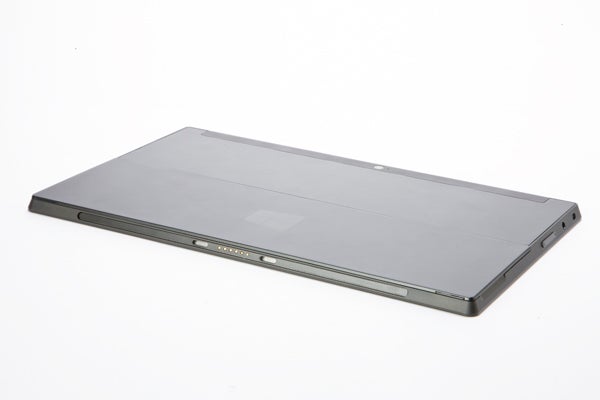
It’s also apparent that ‘angular’ was a definite buzz-word when the Surface was being designed. There’s not a single curve or tapered edge on this tablet, except for the slightly rounded outer corners. It’s a great look that unequivocally sets it apart from its rivals, and for those saying its look is not as clean as that of the iPad, wouldn’t you rather have all its connectivity? Unfortunately, Surface’s slightly unapologetic edges do mean it’s not quite as comfy to hold though. 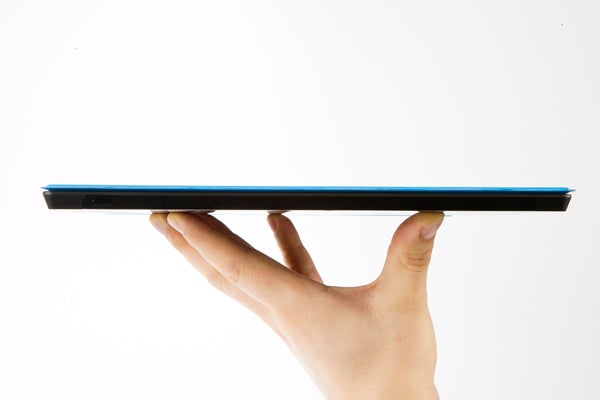
The Microsoft Surface’s entire chassis is constructed using a unique VaporMg magnesium alloy which is three times lighter than aluminium yet just as durable. This is a good thing, as the Surface already weighs 18g more than the heaviest iPad. However, keep in mind that at 10.6-inches, it’s markedly larger than the 9.7-inch iPad too, so it’s quite light considering. Despite appearances, it’s also nearly as thin, adding only 0.2mm.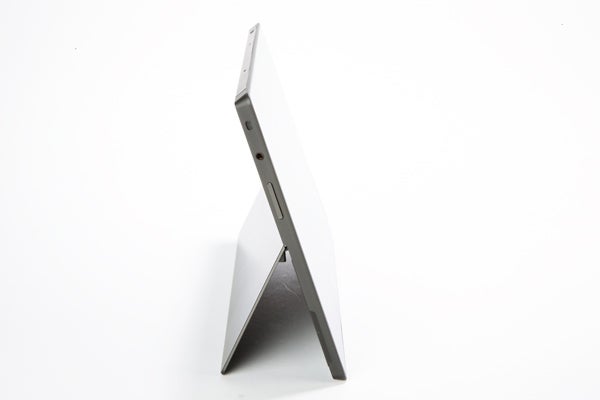
Build quality is simply superb. Nowhere on this tablet is there any sign of cut corners, and the matt black metal feels superb in the hand. The entire tablet has been treated with anti-fingerprint coating, which definitely helps as the metal parts only show marks after extensive prodding. The only plastic part is a soft-touch strip at the top which houses the rear camera and improves wireless reception. The entire front is protected by Gorilla Glass 2.
Microsoft Surface Connectivity
Essentially, Microsoft includes pretty much every connection you need, though there are no extras. Along the left is a 3.5mm headphone jack; responsive and comfy volume rocker; and insert to pull out the kickstand, which we’ll get to in a minute. At the tablet’s top you’ll find the power button along with dual array microphones. 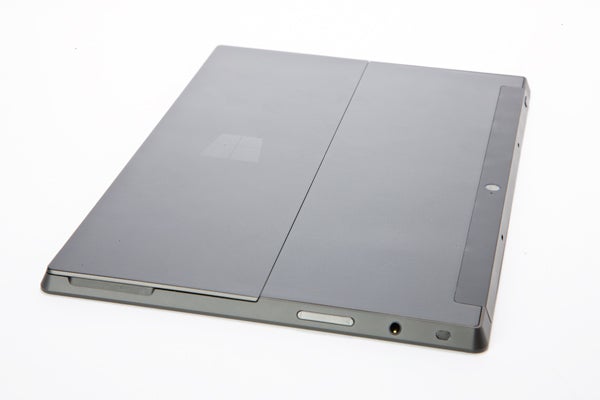
On the right we have the magnetic power connector, a full-size USB 2.0 port for hooking up everything from memory sticks to printers or peripherals, and a microHDMI port for outputting video to a monitor or telly. Microsoft also sells a VGA adapter for £35 (Apple charges £39 for its Lightning to VGA one), for those still using the analogue standard.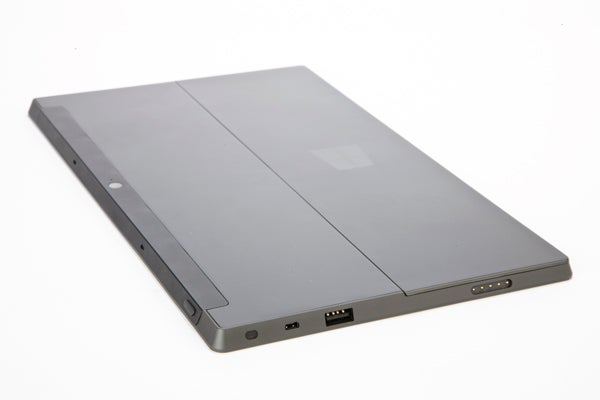
Under the kickstand you’ll also find a microSDXC card slot for expanding internal memory, so you can easily give the Surface an extra 64GB of storage for music and movies (it doesn’t work for apps) for under £50.
On the wireless front, we have Bluetooth 4.0 and some impressive Wi-Fi N thanks to dual antennas. Unfortunately, there’s no 3G/4G version of Microsoft’s Surface (yet), a definite disadvantage compared to the iPad and some Windows RT rivals. NFC, as found on most premium Android tablets, doesn’t make the cut either, which is a real shame as it offers some neat current functionality and a lot of future potential.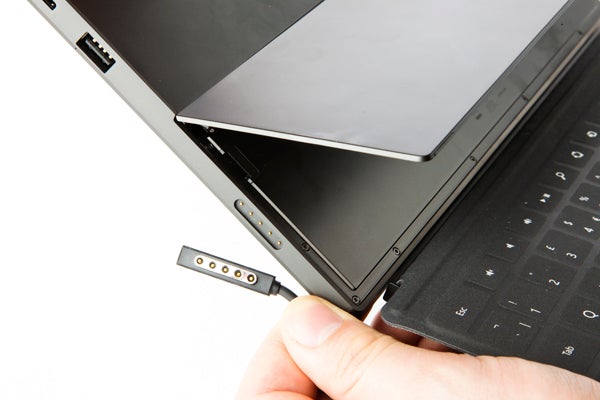
Another niggle is that the aforementioned proprietary magnetic power connector is rather awkward. Where the Surface’s bottom keyboard connector pulls itself into place effortlessly (as does the similar MagSafe charging system used on Apple laptops), the power plug requires careful insertion which can be very fiddly. We hope this is something Microsoft will fix for the Surface Pro.
Microsoft Surface Kickstand
Here is something its rivals can’t offer: Microsoft’s Windows RT tablet has a kickstand. Now this might not sound like much, but keep in mind that most other (non-convertible) tabs need a case to stand upright on a table or desk, while with the Surface it’s part of the ‘bare’ package.
The kickstand extends the entire length of the device but is beautifully integrated. It will never open by accident, and it won’t snap closed unexpectedly either. Microsoft has put a lot of time and research into its mechanism, and it shows. Just make sure your fingertips are out of the way when you close it.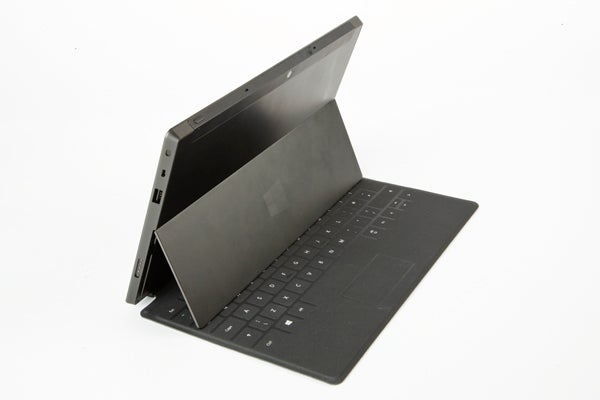
You can’t adjust the stand to various angles, but Microsoft has chosen a good 22-degree default (again, lots of research including reflection, ergonomics, desk height etc). With its ‘leg’ extended, the Surface is very stable on a flat… erm… surface and pretty secure on your lap. Its kickstand is an essential ingredient in how Microsoft’s tablet gels with its keyboard cover, which is yet another trump-card it holds over the Apple iPad/Google Nexus competition.
Microsoft Surface Touch Cover and Surface Type Cover: Keyboard and Touchpad
To go with Office on the software side, Microsoft also provides the hardware tools to make its Surface one of the most appealing tablets for productivity: optional keyboard covers. These are very similar to your average magnetic tablet cover, except they’re far more robust and secure, and you can also type on them –the Surface Type Cover even manages to squeeze physical keys into its svelte 5mm thinness.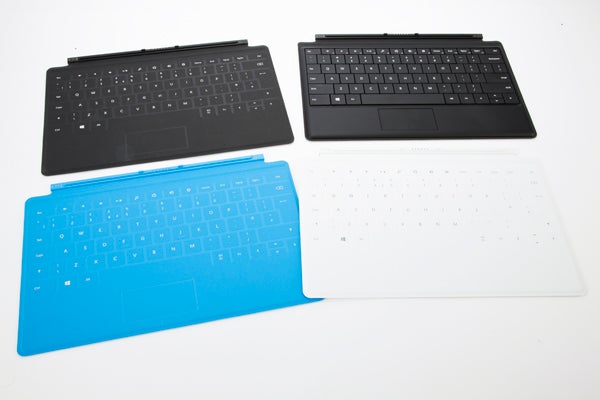
We’ll get onto the typing experience these covers offer in a moment, but first let’s talk about the details. The bundled keyboard cover comes in black to match the tablet, though you can get the Touch Cover in Blue or White too. They latch onto the base of the Surface using a magnetic clasp that pulls the cover in smoothly and holds it so securely that you can dangle the tablet by its cover without worries. This is very impressive indeed.
Naturally, like any smart cover these Microsoft efforts turn the Surface tablet on or off when you open and close them. The good news continues: if you flip the cover back when it’s not in use, an accelerometer sensor ensures the keys will deactivate so that they don’t accidentally get ‘pressed’. 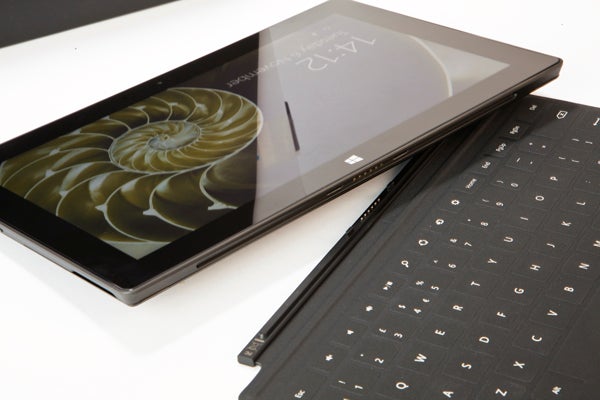
You can also fit the cover both ways around; so you can have the keyboard towards the front or, if you want to use it to protect the Surface’s back without the keys being visible, simply turn it and attach the other way – genius.
On their bottom, both black keyboard covers sport a felt-like material finish that was developed by Nike for its sports wear. It’s durable and anti-slip, keeping the tablet firmly in place on a smooth surface or sloping legs. From a design point of view it was quite divisive in the TR office, with some likening the material to carpet while others enjoyed its unique look and feel. Oddly, the blue and white Touch Covers don’t offer this finish on their bottom.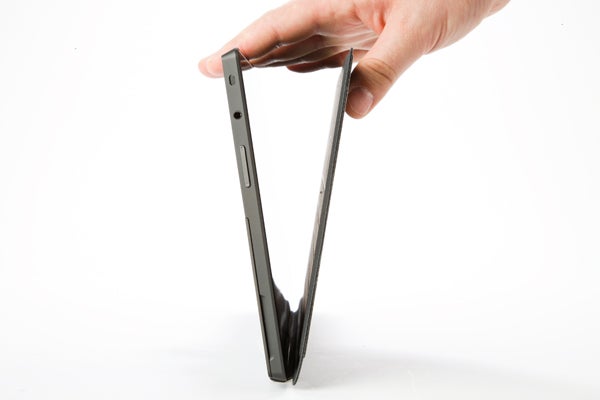
There’s no cover included with the £400 base Surface, and buying the Touch one bundled will set you back £480. That’s a decent saving considering the Touch Cover alone costs £100.
The Surface Type Cover is only available separately for £110. It offers nearly full-size keys with better action and layout than you would find on many laptop keyboards. Unfortunately, it doesn’t feel as sturdy as a Touch and our model suffered from repeated unregistered keystrokes, especially if used on a lap rather than a desk. 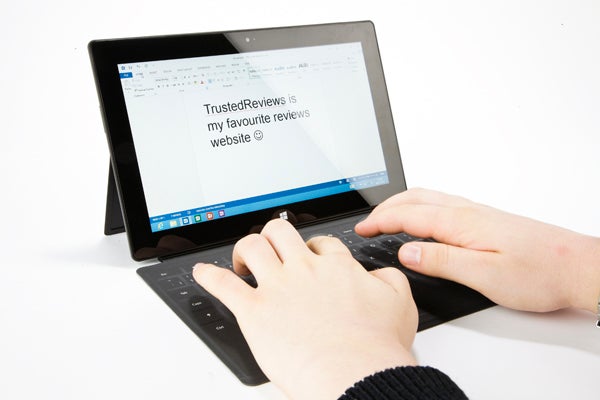
For this and its 3mm thinness, we prefer the Touch Cover, whose typing experience pleasantly surprised us. Indeed, before we got some extensive time in with the Touch and the Type, we were convinced the Type Cover would be our favourite, but despite its lack of physical feedback and smaller ‘keys’, the Touch works flawlessly.
Laid out nicely, the Touch Cover’s ‘keys’ are raised with indents between them. They might not move, but confirmation is provided by the mere fact that you hit them, along with an unobtrusive sound from the Surface tablet. After some initial disorientation, we were typing blind at close to our regular speed within minutes. 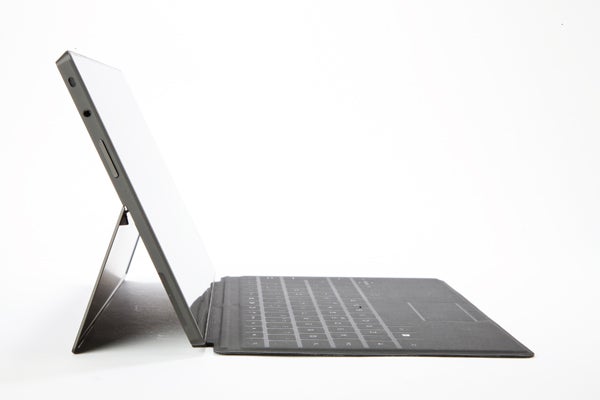
Whether you hit a ‘key’ hard or gently it usually registers without fail, and we typed the first page of this review with only twelve typos caused by the cover rather than human error. Either way it’s quite simply the best typing experience we’ve yet come across on a tablet, and Windows RT’s virtual keyboard easily matches the best that Android and iOS have to offer too. It’s just a shame the Type Cover doesn’t work well on irregular surfaces.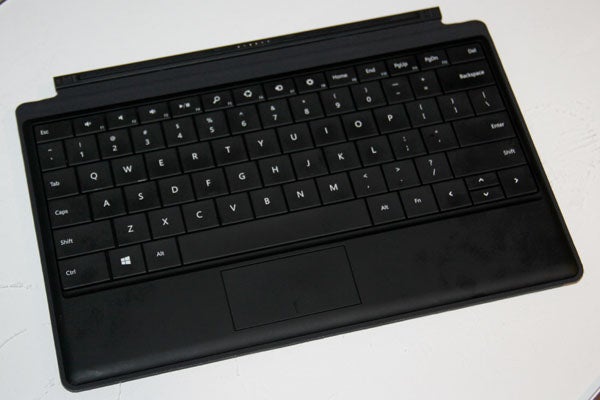
The touchpads on both keyboard covers work superbly, being very responsive with support for multi-touch. Basically, aside from their small size they offer an identical experience to those on a laptop. Even the Touch Cover trackpad gives you distinct right and left click ‘buttons’.
Microsoft Surface Screen
Its 10.6in IPS screen is probably the most controversial part of the Surface, thanks to the iPad, Nexus 10, Asus Transformer Infinity and other premium tablets eliminating those pesky pixels from sight with insanely high resolutions, a phenomenon Apple calls “Retina Display”. For its non-Pro Surface, however, Microsoft went with a ‘bog-standard’ 1,366 x 768 pixels (that’s around 148ppi).
However, it’s important not to make too much of this. Keep in mind that as recently as 2011, 1,366 x 768 was the standard resolution on laptops with screens as large as 16 inches, and generally the Surface’s display looks nice and sharp.
Text also appears clearer than on most tablet displays with a similar ppi, thanks to Microsoft’s ClearType fonts tech (which has been available in Windows since XP). This can access individual colour-stripe elements in every pixel to display text details a fraction of a pixel wide, smoothing out the appearance of fonts considerably. Naturally the iPad/Nexus/Transformer win out on sharpness but it’s not too dramatic.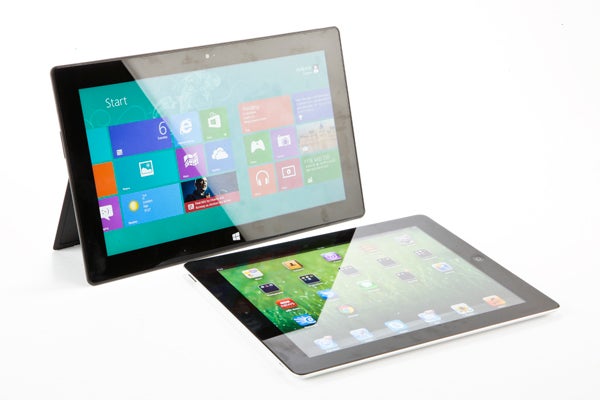
Surface above, iPad below, showing the difference in aspect ratio
Contrast on the Surface’s screen is pretty good, with a lot of dark detail visible without compromising whites too much – here the Microsoft tab outperforms most rivals including the iPad. As with most premium tablets, viewing angles on the Microsoft Surface’s screen are pretty much flawless, and reflections are minimised by the display being a single layer, similar to the Cell screens found on recent high-end smartphones.
Combined with no noticeable backlight bleed and only slight lighting unevenness, this makes the Surface a great little tablet to watch movies on, where its 16:9 aspect ratio also comes into its own. However, we do really miss those extra vertical pixels for web-browsing and reading. Though it’s probably on the way out, 1,280 x 800 (or 1,920 x 1,200 if you’re talking Full HD plus) is still the tablet ideal in our books.
Microsoft Surface Speakers
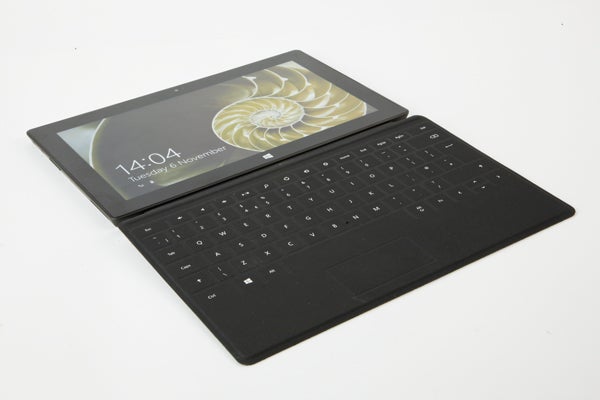
Let’s face it: most tablets sound rubbish. Some of them don’t even have stereo speakers, and with most that do you wouldn’t notice. It’s also often the case that holding the tablet in a certain way covers the speakers.
Thankfully, we’re seeing more and more tablets that are worth listening to, like the Samsung Galaxy Note 10.1 with its front-facing stereo efforts. Surface joins this crowd with some seriously impressive sound from its tiny side-facing speakers, positioned where you’re unlikely to accidentally cover them. Good volume, plenty of clarity and a decent mid-range mean we’d use these for entertainment in a pinch – just don’t expect them to match a laptop or earbud headphones.
Microsoft Surface Specs and Performance
Its specifications are probably the least exciting thing about the Microsoft Surface tablet. It sports a quad-core Nvidia Tegra 3 processor (though if we’re being accurate there are actually five cores thanks to a fifth ‘companion’ core for light use), specifically the T30 SKU where the four main cores run at 1.4GHz. This is the exact same chip found in the Asus Transformer Prime and only a small step up from the one used in the £150-ish Google Nexus 7, but it’s more than powerful enough for what is, after all, primarily a tablet.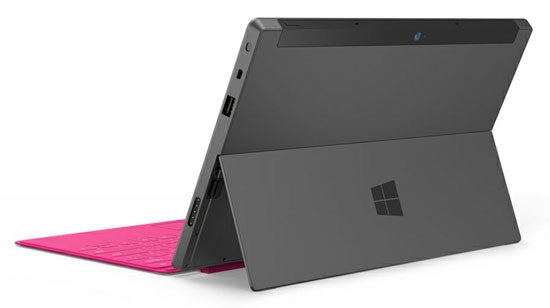
Thanks to its 12 graphics cores you get decent 3D gaming performance, and Microsoft has backed the Tegra 3 SoC with 2GB of RAM which makes for smooth multi-tasking and gives a little wiggle-room to demanding applications. These specs will be identical on the first wave of Windows RT tablets from other brands that we’ve seen, meaning developers have a stable platform to work on.
On the storage front, as mentioned you can get the Surface with either 32GB or 64GB. There is no 16GB Surface, which makes sense as Windows RT and Office 2013 combined with the other pre-installed apps take up nearly 12GB. However, keep in mind that you can add extra storage for music, videos, pictures and documents using the microSD card slot, which officially supports 64GB cards and should work with 128GB models.
Microsoft Surface Battery Life
Being an ARM-architecture tablet, you would expect good battery life from the Surface, and it delivers. In a general usage test (productivity, gaming, and browsing, with Wi-Fi switched on half the time) its 35Whr battery managed a full 9-hour day with some left over. 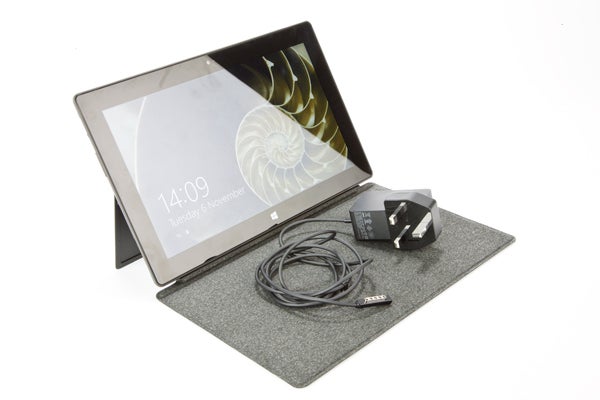
We’ll come back with video results but, based on shorter tests, you should see similar figures when watching HD movies or TV shows. This is a good result and mostly competitive with the new iPad. However, it doesn’t begin to match what we can expect from convertible tablets with dual batteries, like the Acer Iconia W510 which claims up to 18hrs on a charge and runs ‘proper’ X86 Windows 8. It would be very interesting if Microsoft decided to get into the convertible game at some stage…
Microsoft Surface Cameras
Let’s not mince words: though Windows RT’s simplistic camera interface is nice, the HD cameras on the Surface are rubbish. This is the only aspect of Microsoft’s tablet that left us genuinely disappointed. Both front and rear units support 720p video that’s fine for video-chatting, but you really don’t want to take any important snaps using Surface.

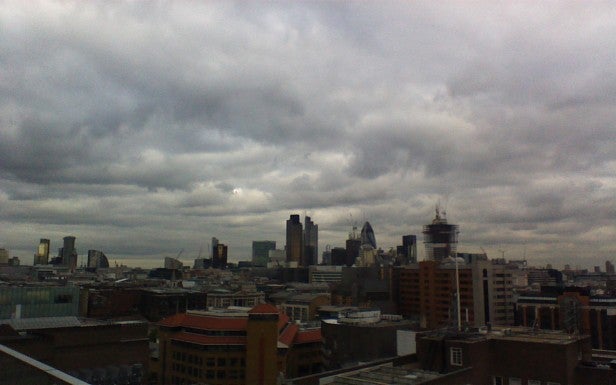
Compared to the fast glass, high fps shooting, quick AF, 1080p video and LED flash support on some rival tablets, the cameras here are pitiful. Even relatively well-lit stills lack detail, decent contrast, good focus and all the other essentials for a nice pic. Arguably this is not a big deal as there’s always your phone or dedicated camera, but it’s far from ideal to be so far behind the competition on what is, after all, Microsoft’s only tablet for now.
Microsoft Surface OS: Windows RT
Windows RT is virtually indistinguishable from regular Windows 8, and that’s a good thing. All the advantages over ‘vanilla’ Android and iOS operating systems are present: proper multi-tasking, universal split-screen, a ‘desktop’ Windows interface familiar to those used to Windows 7, and more.
Read the full Windows 8 review here
For example, you know Adobe’s Flash? The iPad has never been able run it, and since Android version 4.1 AKA Jelly Bean, Google’s OS no longer plays nice with it either. But Windows RT still supports it – albeit with some caveats. Microsoft keeps a ‘white list’, to which websites need to apply before they will work on RT. Mind you, this is not totally a bad thing, as it means that all Flash content that’ll work on the Surface won’t crash your tablet. 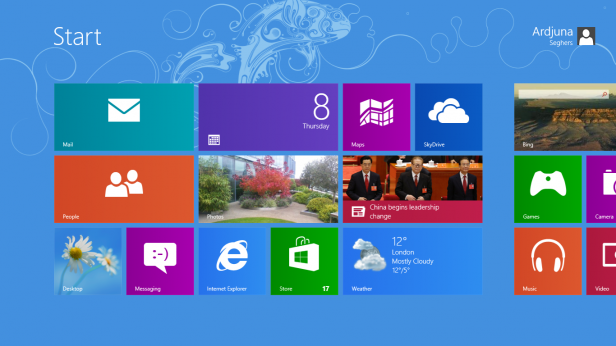
Then there’s how everything just works. Not just popular Flash websites but pictures and documents in all kinds of formats will happily be read by Windows RT – and if the OS can’t read it, it will present you with apps that can.
On multi-tasking, in the tile interface formerly known as Metro you can view two apps simultaneously with a 1/3 – 2/3 split. It’s not always ideal and obviously it doesn’t work that well for all the Windows Store apps, especially given the Surface’s 1,366 x 768 resolution. However, it’s great for keeping an eye on things like IM, news feeds, twitter, notifications and the like. And if you fancy traditional split-screen multi-tasking, just pop into the Desktop interface.
No other tablet OS lets you do this, though Samsung has modified Android on its Galaxy Note 10.1 tablet and Galaxy Note 2 phablet to allow a semblance of it for a limited number of apps. 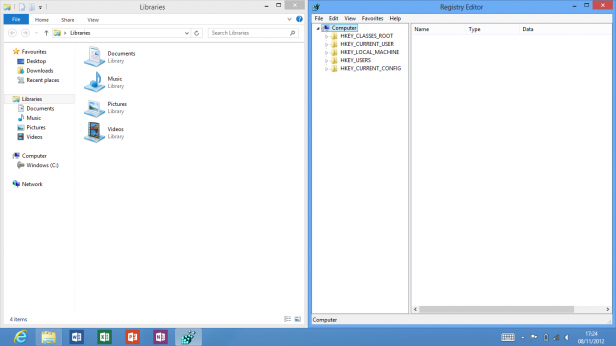
In the desktop mode you can also tinker with Windows’ innards like no other mobile OS, calling up a command prompt and even going so far as to mess around with the registry (simply type ‘regedit’ into Run). This allows you to mess with the guts of the OS, and there are apps that will let you make significant changes too. As mobile operating systems go, Windows RT is a geek’s wet dream.
Perhaps best of all is that you can plug in so many of the same peripherals you’re used to using with your computer or laptop and they just work. No hacks, tweaks, apps, drivers, adapters or any hassle: simply plug in a mouse, keyboard, printer, webcam and the like and, chances are, it will work flawlessly within seconds. The same goes for game controllers.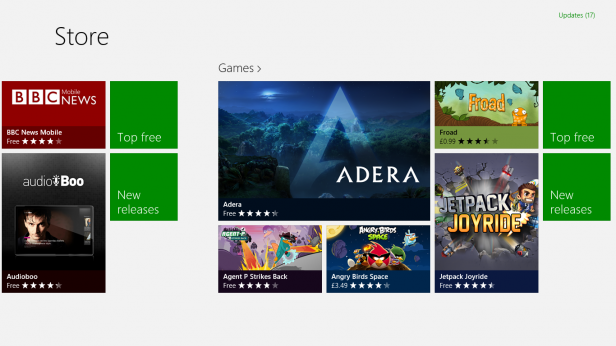
You do need to keep in mind that Windows RT has been designed for ARM devices, and your legacy X86 software for Windows XP/Vista/7 etc won’t work on RT – nor will new apps for Windows 8 until they’re ported. There’s also a major lack of choice on the Windows app store, especially compared to Android and iOS. But with apps being easy to port from Win8 and lots of developer incentives to get behind the latest versions of the world’s biggest OS, we don’t think the app drought will last long.
Our only major complaint with Windows RT itself (and Windows 8 when used on a mobile device) is that there is no way to see remaining battery life in a percentage without going into the desktop, something Microsoft will hopefully fix soon with an update.
Windows RT’s Office 2013: Productivity Comes to Tablets at Last
One of the biggest draws of Surface – and indeed every other Windows RT tablet – is that Microsoft’s OS for ARM comes with what is essentially the full version of Office 2013 Home & Student (it’s the ‘Preview’ software for early adopters but will be updated when the full software is released). The only component that’s missing is Outlook, and arguably Microsoft’s new web-based version is an adequate replacement.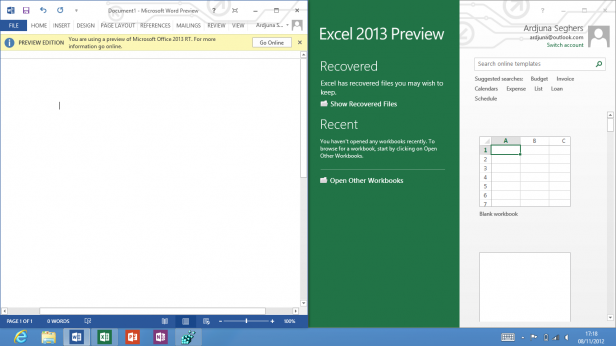
Every other favourite is there: Word, Excell, PowerPoint and OneNote are all present and accounted for, in just the ways you know and love them – that’s why RT automatically switches to the Desktop mode when you launch any of these.
For those few who don’t know what Microsoft Office is, it’s the best productivity suite on the planet bar none, and the fact that you can now have it on your tablet undiluted is, frankly, tremendously exciting. As on Windows 8, Office syncs with Microsoft’s SkyDrive flawlessly to give it much the same potential as Google Drive, and it will keep everything in sync with your other Windows devices too, including your desktop/laptop and Windows Phone 8 mobile.
Microsoft Surface – Price
32GB = £399 (compared to £479 for the same capacity iPad)
32GB with Touch Keyboard Cover = £479
64GB with Touch Keyboard Cover = £559
The basic Microsoft Surface model with 32GB of storage will set you back £399 – the same price as a 16GB new iPad. To be honest we’re thinking Microsoft could easily have priced its tablet a little lower, but it still presents pretty good value. 
However, to really explore this tablet’s potential we think it’s essential to get one of the keyboard covers, so we would definitely go for the £479 32GB or £559 64GB bundles. To put these prices into perspective, a 32GB iPad costs £479 on its own, so when comparing like for like you’re essentially getting the Surface with Touch Cover for the same price as an iPad 4.
Though it’s a gross oversimplification, you could summarise the difference between these two tablets as such: if you want mobile gaming and the biggest selection of quirky apps, go with Apple’s tablet. If you want to use your tablet for watching movies, for productivity, often type long emails, want to hook up peripherals, and/or have a main Windows 8 machine, Microsoft’s Surface makes more sense.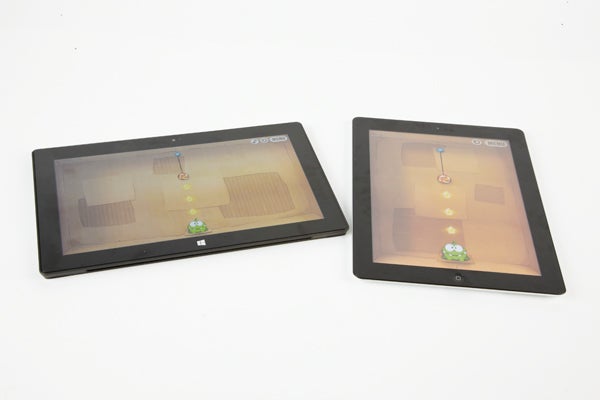
Comparisons with Android tablets are a little more difficult, since there are so many of them. Convertible Android 4.1 Jelly Bean tablets like the Asus Transformer Pad TF300T with its 14hr battery life and keyboard dock offer many of the same advantages as the Surface and 32GB models can be found for under £380. If you want the tablet experience with a little casual productivity this beats both the iPad and Surface by a significant margin thanks to its super-affordable price. 
However, the biggest threat to Surface comes from other Windows RT convertible tablets like the and – and, more surprisingly, Windows 8 convertibles. Models like the Acer Iconia W510 can be found for under £480. For the same price as a Surface plus keyboard cover, you’re getting a smaller convertible tablet that offers the same features but with longer battery life, extras like NFC, and a proper ‘laptop’ feel – and crucially, its Atom processor gives you the full-fat version of Windows 8 which can run all your old apps (those the CPU/GPU can handle, that is). Admittedly you don’t get the same superb build quality or Microsoft’s Office included, but that’s hardly enough to give Surface a clear win. 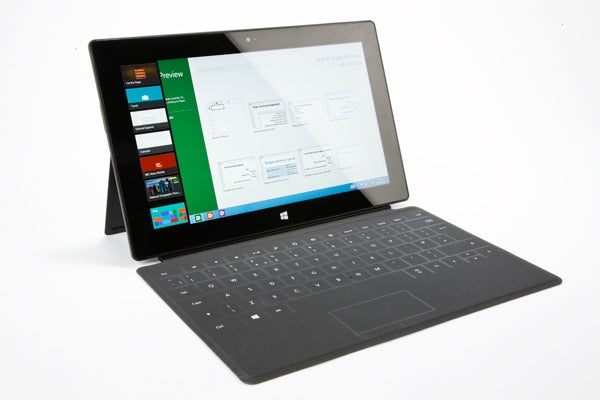
Verdict
Microsoft is making a very strong entry to the tablet market with the Microsoft Surface running Windows RT. It offers a unique design combined with build quality and attention to detail that few others can match. It sounds superb, has a great (if slightly low-res) screen, and offers excellent battery life. And if the tablet itself is good, its optional keyboard covers are simply great, combining with the full Microsoft Office suite that comes with Win RT to make the Surface a true productivity solution.
However, its app selection is quite limited for now. More importantly, the advantages Windows RT brings to the table aren’t exclusive to Microsoft’s Surface tablet, and with some ‘full-fat’ Windows 8 tablets offering a similar feature set at around the same price, we can’t say that Surface is blowing us away. Maybe the Microsoft Surface Pro will be the one to rule them all.
How we test tablets
We test every tablet we review thoroughly. We use industry standard tests to compare features properly and we use the tablet as our main device over the review period. We’ll always tell you what we find and we never, ever, accept money to review a product.
Trusted Score
Score in detail
-
Performance 9
-
Value 8
-
Design 8
-
Screen Quality 8
-
Features 8
-
Battery Life 8
Other
| Processor | Tegra 3 |
| Memory (RAM) (Gigabyte) | 2GB |
| Internal Storage (Gigabyte) | 32-64GB |
| Mobile Broadband/3G | No |
Display
| Resolution | 1366 x 768 |
| Operating System | Windows RT |
| Display Type | LCD IPS |
| Display Size (Inch) | 10.6in |

